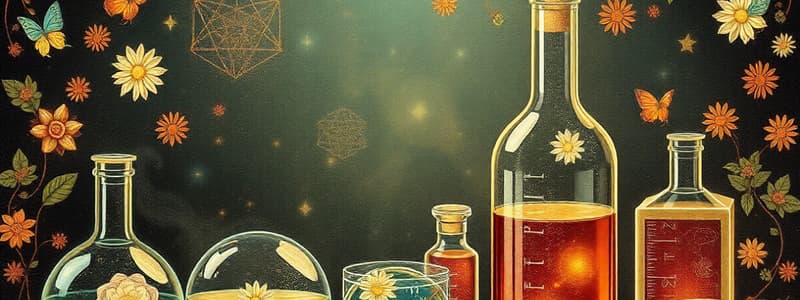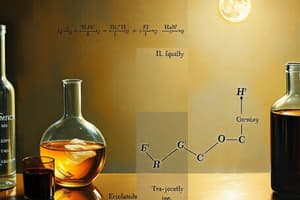Podcast
Questions and Answers
What is a chemical reaction?
What is a chemical reaction?
A chemical reaction is a process where one or more substances, called reactants, are transformed into one or more different substances, called products.
What is a balanced chemical equation?
What is a balanced chemical equation?
A balanced chemical equation is one where the number of atoms of each element on the reactant side is equal to the number of atoms of that element on the product side.
What is an unbalanced or skeletal chemical equation?
What is an unbalanced or skeletal chemical equation?
An unbalanced chemical equation is one where the number of atoms of each element on the reactant side is not equal to the number of atoms of that element on the product side.
What is the law of conservation of mass?
What is the law of conservation of mass?
Why are chemical equations balanced?
Why are chemical equations balanced?
What is a combination or synthesis reaction?
What is a combination or synthesis reaction?
What is a decomposition or breakdown reaction?
What is a decomposition or breakdown reaction?
What is an exothermic reaction?
What is an exothermic reaction?
What is a displacement or single displacement reaction?
What is a displacement or single displacement reaction?
What is a double displacement reaction?
What is a double displacement reaction?
What is oxidation?
What is oxidation?
What is a redox reaction?
What is a redox reaction?
What is corrosion?
What is corrosion?
What is rancidity?
What is rancidity?
What is neutralization?
What is neutralization?
What is a precipitate?
What is a precipitate?
What is roasting?
What is roasting?
What is an amalgam?
What is an amalgam?
What is metallurgy?
What is metallurgy?
What are amphoteric oxides?
What are amphoteric oxides?
What is a chemical bond?
What is a chemical bond?
What is an ionic bond?
What is an ionic bond?
What is a covalent bond?
What is a covalent bond?
Why is sodium metal stored in kerosene?
Why is sodium metal stored in kerosene?
What is an isomer?
What is an isomer?
What is halogenation?
What is halogenation?
What is saponification?
What is saponification?
What is a detergent?
What is a detergent?
What are fossil fuels?
What are fossil fuels?
What is a hydrocarbon?
What is a hydrocarbon?
What is a functional group?
What is a functional group?
What is a homologous series?
What is a homologous series?
What is the vital force theory?
What is the vital force theory?
What is water conservation or rainwater harvesting?
What is water conservation or rainwater harvesting?
What is the difference between Mendeleev's periodic table and the modern periodic table?
What is the difference between Mendeleev's periodic table and the modern periodic table?
What is the significance of the atomic number in the periodic table?
What is the significance of the atomic number in the periodic table?
What is RRR?
What is RRR?
What is environmental management?
What is environmental management?
What is the modern periodic law?
What is the modern periodic law?
What are non-conventional energy sources?
What are non-conventional energy sources?
What are some uses of solar energy?
What are some uses of solar energy?
What is biogas?
What is biogas?
What is the difference between soap and a detergent?
What is the difference between soap and a detergent?
What is a catalyst?
What is a catalyst?
What is the effect of deforestation on wildlife?
What is the effect of deforestation on wildlife?
How does deforestation negatively affect the environment?
How does deforestation negatively affect the environment?
What is the role of a functional group in organic chemistry?
What is the role of a functional group in organic chemistry?
How do carbon compounds show a vast array of properties?
How do carbon compounds show a vast array of properties?
Why is copper used for making hot water tanks?
Why is copper used for making hot water tanks?
Flashcards
Chemical Reaction
Chemical Reaction
A process in which one or more substances react to form a new substance with different properties
Chemical Equation
Chemical Equation
A symbolic representation of a chemical reaction using chemical formulas and symbols
Balanced Chemical Equation
Balanced Chemical Equation
An equation where the number of atoms of each element is equal on both sides of the equation
Unbalanced Chemical Equation
Unbalanced Chemical Equation
An equation where the number of atoms of at least one element is not equal on both sides.
Signup and view all the flashcards
Law of Conservation of Mass
Law of Conservation of Mass
The total mass of the reactants in a chemical reaction is equal to the total mass of the products
Signup and view all the flashcards
Combination Reaction
Combination Reaction
Two or more reactants combining to form a single product
Signup and view all the flashcards
Decomposition Reaction
Decomposition Reaction
A single reactant breaks down into two or more simpler products
Signup and view all the flashcards
Exothermic Reaction
Exothermic Reaction
A reaction that releases energy, usually in the form of heat
Signup and view all the flashcards
Endothermic Reaction
Endothermic Reaction
A reaction that absorbs energy, usually in the form of heat
Signup and view all the flashcards
Displacement Reaction
Displacement Reaction
One element displaces another from its compound
Signup and view all the flashcards
Double Displacement Reaction
Double Displacement Reaction
Two ionic compounds react, exchanging ions to form two new compounds.
Signup and view all the flashcards
Neutralization Reaction
Neutralization Reaction
Reaction between an acid and a base, producing a salt and water
Signup and view all the flashcards
Precipitation Reaction
Precipitation Reaction
A reaction where a solid (precipitate) forms when two solutions are mixed
Signup and view all the flashcards
Oxidation Reaction
Oxidation Reaction
A reactant gains oxygen or loses hydrogen
Signup and view all the flashcards
Reduction Reaction
Reduction Reaction
A reactant loses oxygen or gains hydrogen
Signup and view all the flashcards
Redox Reaction
Redox Reaction
Both an oxidation and a reduction reaction happen at the same time
Signup and view all the flashcards
Corrosion
Corrosion
The deterioration of a metal due to a chemical reaction with its environment
Signup and view all the flashcards
Rancidity
Rancidity
Spoilage of fats and oils
Signup and view all the flashcards
Acid
Acid
A substance that tastes sour, turns blue litmus paper red, and releases hydrogen ions (H+) when dissolved in water
Signup and view all the flashcards
Base
Base
A substance that tastes bitter, turns red litmus paper blue, and releases hydroxide ions (OH-) when dissolved in water
Signup and view all the flashcards
Indicator
Indicator
A substance that changes color in the presence of an acid or a base
Signup and view all the flashcards
pH scale
pH scale
A scale that measures the acidity or basicity of a solution
Signup and view all the flashcards
Alloy
Alloy
A mixture of two or more metals or a metal and a nonmetal
Signup and view all the flashcards
Ductility
Ductility
The ability of a substance to be drawn into thin wires
Signup and view all the flashcards
Malleability
Malleability
The ability of a substance to be hammered or rolled into thin sheets
Signup and view all the flashcardsStudy Notes
Chemistry Revision Notes
-
Chemical Reactions and Equations:
- A chemical reaction is a process where a substance reacts with itself or another substance to form a new substance with different properties.
- A chemical equation represents a chemical reaction using symbols and formulas.
- A balanced chemical equation ensures the conservation of mass, with an equal number of each atom on both sides.
- Unbalanced/skeleton equations lack conservation of mass.
- Chemical equations are balanced to satisfy the law of conservation of mass, where the total mass of reactants equals the total mass of products.
-
Types of Chemical Reactions:
- Combination/Synthesis: Two or more substances combine to form a single new substance. Example: C + O₂ → CO₂
- Decomposition: A single compound breaks down into two or more simpler substances. Example: CaCO₃ → CaO + CO₂
- Single Displacement: A more reactive element replaces a less reactive element in a compound. Example: Fe + CuSO₄ → FeSO₄ + Cu
- Double Displacement: Two compounds exchange ions to form two new compounds. Example: NaCl + AgNO₃ → AgCl + NaNO₃
-
Other Important Reactions:
- Exothermic: Reactions releasing heat. Example: 2H₂ + O₂ → 2H₂O + energy
- Endothermic: Reactions absorbing heat. Example: C + H₂O → CO + H₂ + energy
- Neutralization: An acid reacting with a base to form salt and water. Example: HCl + NaOH → NaCl + H₂O
- Oxidation: Gain of oxygen or loss of hydrogen; a substance that gains oxygen. Example: C + O₂ → CO₂ Example: Compounds containing hydrogen losing hydrogen.
- Reduction: Gain of hydrogen or loss of oxygen; a substance that gains hydrogen
- Redox: Simultaneous oxidation and reduction in a reaction.
-
Acids, Bases, and Salts:
- Acids have sour taste, turn blue litmus paper red, low pH (less than 7), and release H⁺ ions in water.
- Bases have bitter taste, turn red litmus paper blue, high pH (greater than 7), and release OH⁻ ions in water.
- Neutralization reactions yield salt and water.
- Common food acids: Citric acid (in citrus fruits), malic acid (in apples), tartaric acid (in tamarind), acetic acid (in vinegar), lactic acid (in yogurt), oxalic acid (in tomatoes), hydrochloric acid (in stomach acid), tannic acid (in tea), ascorbic acid (in vitamin C), formic acid (in ants).
-
Metals and Nonmetals:
- Metals: Usually solid at room temperature, good conductors of heat and electricity, ductile (can be drawn into wires), malleable (can be hammered into sheets), and have high density. Example: Iron, copper, nickel, etc.
- Nonmetals: Can be solid, liquid, or gas at room temperature, poor conductors of heat and electricity, not ductile or malleable, and have low density. Example: Carbon, oxygen, chlorine, etc.
-
Alloys: Mixtures of two or more metals (or a metal and a nonmetal). Example: Brass (copper and zinc), bronze (copper and tin).
-
Corrosion: Deterioration of metal by chemical reactions with the environment. Example: Rusting of iron.
-
Important Chemical Compounds:
- Baking soda (Sodium hydrogen carbonate): Use in baking, antacids, fire extinguishers, cleansing agents.
- Bleaching powder (Calcium oxychloride): Bleaching, disinfecting water, textiles, paper.
-
Other Concepts:
- Corrosion: Deterioration of metals.
- Alloys: Mixtures of metals.
- Electrolyte A substance that conducts electrical current in an aqueous solution or molten state.
- Neutralization: A reaction between an acid and base that forms salt and water.
- Atom: The basic unit of matter.
- Molecule: A group of atoms bonded together.
- Chemical Formula: A combination of chemical symbols showing the ratio of atoms in a compound.
- Ion: An electrically charged particle formed when an atom gains or loses electrons.
- Chemical Equation: A concise representation of a chemical reaction. .
- Balanced Equation: Chemical equation where # of atoms of each element are the same on both sides of the equation.
- Reactants: Substances that undergo changes during a reaction.
- Products: Substances formed after the chemical reaction.
Other Important Topics
(from the OCR data)
- Types of Reactions: Combination, decomposition, single displacement, double displacement, redox, exothermic, endothermic.
- Chemical Properties of Metals and Non-metals: (detailed summary given elsewhere)
- Atomic Structure (Implied): Discussing ions, electrons, and atoms suggests understanding of atomic structure.
- Chemical Bonding (Implied): Terms like covalent and ionic bonds imply a basis of chemical bonding theory.
- Environmental Concepts: Conservation, resource management, water conservation, energy resources, natural resources.
Studying That Suits You
Use AI to generate personalized quizzes and flashcards to suit your learning preferences.




